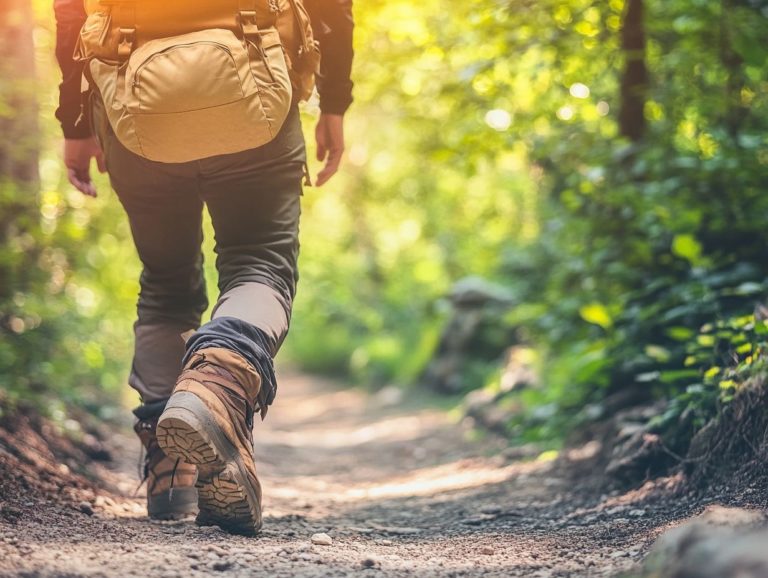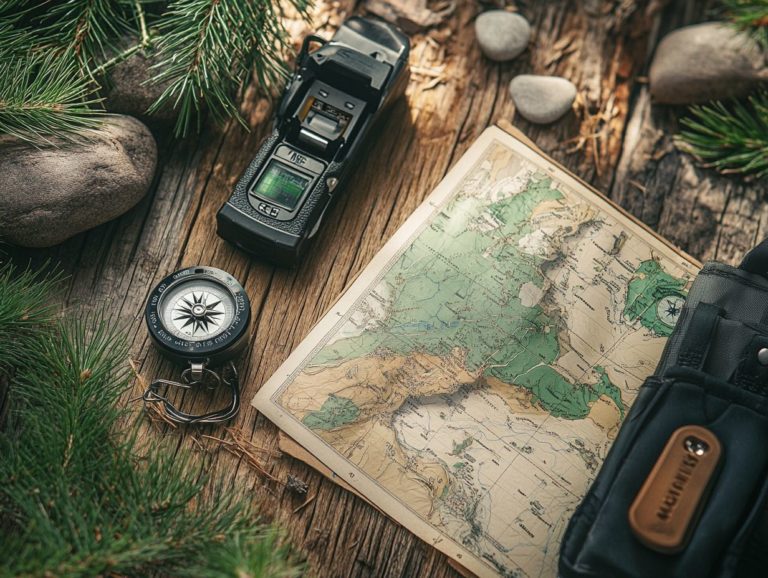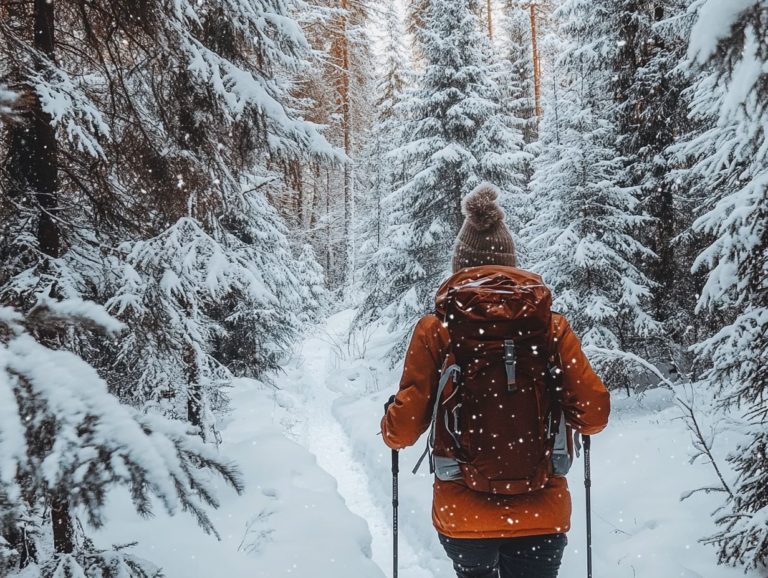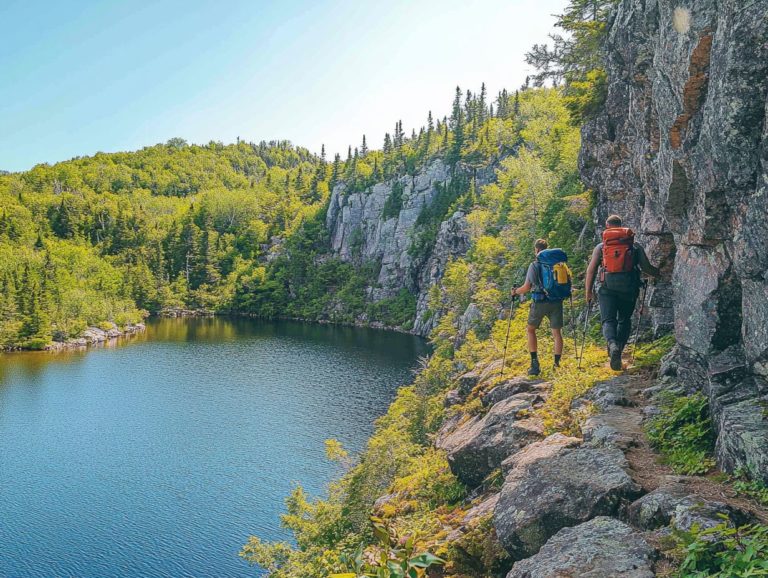Top 5 Lightweight Sleeping Bags for Hikers
When embarking on outdoor adventures, a good night s sleep can truly transform your experience. Selecting the right lightweight sleeping bag is vital for ensuring comfort, warmth, and convenience as you traverse the trails with a focus on ultralight sleeping bags.
This article delves into the top five ultralight sleeping bags that every hiker should have on their radar. It features well-regarded options like The North Face Hyper Cat, the Marmot Helium, and the Feathered Friends Vireo.
Let s uncover essential factors that will help you choose the best sleeping bag for your next adventure, ranging from temperature ratings to insulation types.
Contents
- Key Takeaways:
- 1. The North Face Hyper Cat Sleeping Bag
- 2. Marmot Helium Sleeping Bag
- 3. Therm-a-Rest Hyperion Sleeping Bag
- 4. Sea to Summit Spark Sleeping Bag
- 5. REI Co-op Igneo Sleeping Bag
- What to Look for in a Lightweight Sleeping Bag?
- How Important Is Weight and Packability?
- What Are the Temperature Ratings?
- What Type of Insulation Is Best for a Lightweight Sleeping Bag?
- What Are the Different Shapes and Sizes Available?
- What Are Some Additional Features to Consider?
- How Can a Hiker Determine the Right Sleeping Bag for Them?
- What Are Some Common Mistakes to Avoid When Choosing a Lightweight Sleeping Bag?
- How Can a Lightweight Sleeping Bag Enhance the Hiking Experience?
- What Are Some Tips for Maintaining and Storing a Lightweight Sleeping Bag?
- What Are Some Budget-Friendly Options for Lightweight Sleeping Bags?
- Frequently Asked Questions
- What are the top 5 lightweight sleeping bags for hikers?
- What makes the Therm-a-Rest Hyperion 20 a top choice for hikers?
- Why is the Marmot Hydrogen a popular sleeping bag among hikers?
- What sets the NEMO Disco 15 apart from other lightweight sleeping bags for hikers?
- How does the Western Mountaineering Alpinlite keep hikers warm and comfortable?
- What makes the Feathered Friends Egret Nano 20 a top pick for hikers?
Key Takeaways:
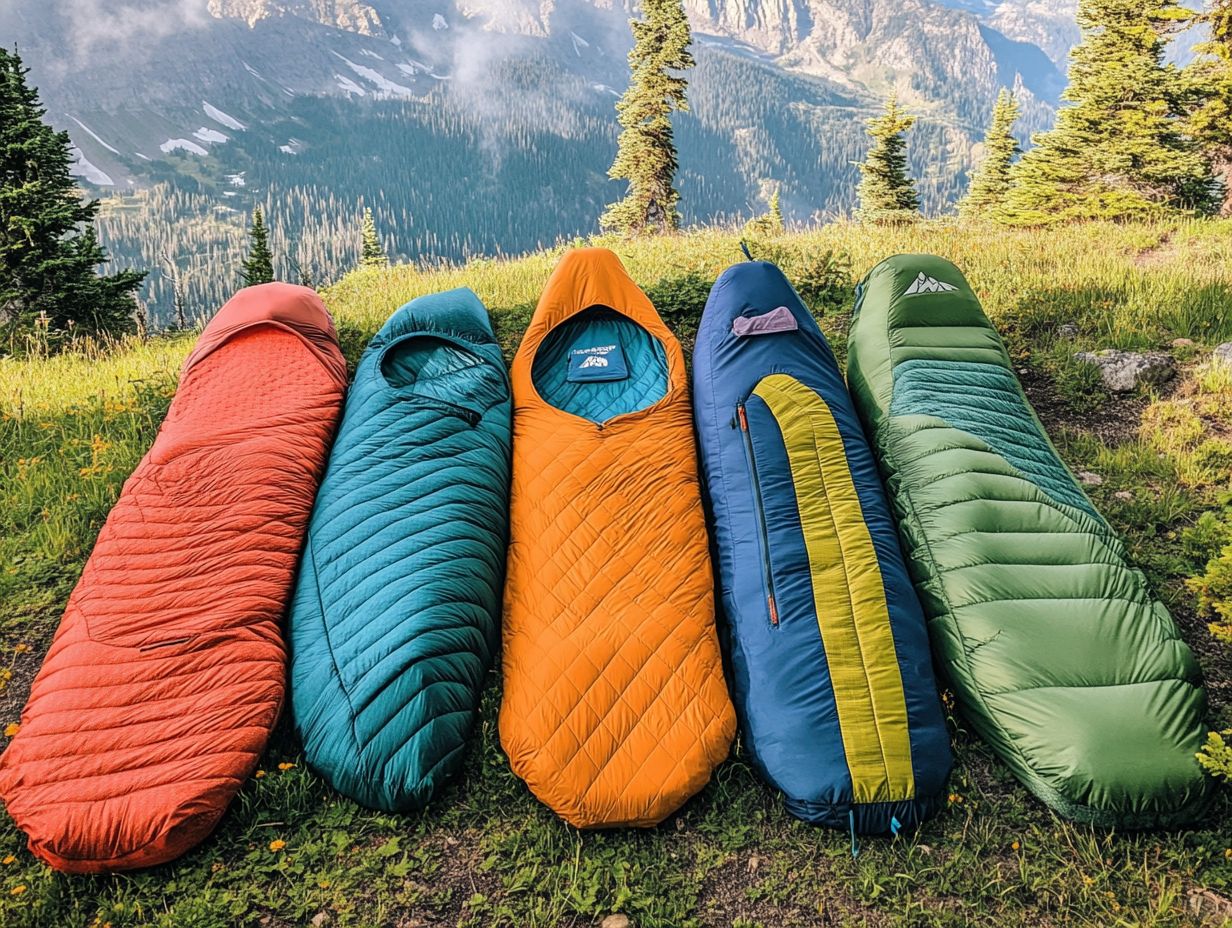
- The right lightweight sleeping bag can significantly enhance a hiker’s experience by providing comfort and warmth without weighing them down.
- When choosing a lightweight sleeping bag, consider factors like weight, packability, temperature ratings, insulation, size, and additional features.
- Some budget-friendly options for lightweight sleeping bags include the North Face Hyper Cat, Marmot Helium, Therm-a-Rest Hyperion, Sea to Summit Spark, and REI Co-op Igneo.
1. The North Face Hyper Cat Sleeping Bag
The North Face Hyper Cat Sleeping Bag stands out as a premier choice among ultralight sleeping bags. It is crafted to deliver exceptional warmth and an impressive warmth-to-weight ratio.
This makes it the perfect companion for your outdoor adventures, whether you re traversing the rugged Colorado Rockies or enjoying the tranquil beauty of Zion National Park. With a remarkable fill power (a measure of how well the insulation traps heat) of 800, this sleeping bag traps heat efficiently while staying incredibly lightweight.
Outdoor enthusiasts rave about this feature during those chilly nights. Its temperature ratings speak volumes; with a comfort rating around 20 F, it ensures you stay cozy even in colder settings.
Combining premium down insulation with a durable outer material, the Hyper Cat not only offers comfort but also stands the test of time. This makes it a formidable contender in the market.
When you stack it up against competitors like Feathered Friends and Therm-a-Rest, the Hyper Cat truly excels. Rigorous product testing and a wealth of user reviews consistently highlight its outstanding balance of packability and performance across various conditions.
2. Marmot Helium Sleeping Bag
The Marmot Helium Sleeping Bag is a standout choice in the ultralight sleeping bag arena. It boasts exceptional down insulation with an impressive 900 fill power.
This bag is perfectly crafted for those chilly nights on backpacking trips when temperatures plunge to 20 F. Weighing in at just under 2 pounds, it is ideal for anyone who values packability without compromising on warmth.
Its durable water-repellent finish offers reliable protection against unexpected moisture, allowing you to venture outdoors with peace of mind. User reviews from OutdoorGearLab highlight the Helium s remarkable comfort and performance.
Adventurers rave about its ability to keep you warm even in the coldest conditions. Many outdoor enthusiasts appreciate how the Helium strikes the perfect balance between insulation and weight, truly setting a new benchmark for ultralight aficionados.
3. Therm-a-Rest Hyperion Sleeping Bag
The Therm-a-Rest Hyperion Sleeping Bag features impressive 950 fill power down insulation. It quickly becomes your go-to choice among ultralight gear enthusiasts. This bag guarantees a cozy sleeping experience even in the biting chill of 20 F, making it perfect for your fastpacking adventures!
Its streamlined design sheds unnecessary weight and enhances packability, catering to those who count every ounce. When comparing it to options from Katabatic Gear and Feathered Friends, the Hyperion truly shines with its premium insulation, showcasing how well it keeps you warm during EN 13537 testing.
Competitors may boast similar temperature ratings, but the Hyperion’s ability to retain loft and warmth in real-world conditions has earned it rave reviews! Weighing just over a pound, it stands out as a lightweight champion in a crowded market, ideal for dedicated trekkers who demand the perfect blend of performance and portability.
4. Sea to Summit Spark Sleeping Bag
The Sea to Summit Spark Sleeping Bag truly distinguishes itself in the ultralight sleeping bag market. It offers exceptional versatility with its lightweight quilt features and a 30 F temperature rating perfect for both minimalist backpackers and those who appreciate a touch of comfort!
Crafted from innovative materials that prioritize weight reduction without sacrificing warmth, the Spark is impressively packable. This makes it an ideal choice for anyone who values efficiency on the trail.
User feedback frequently praises the Spark’s unique design elements, especially its ability to compress into a compact size for easy transport. Customers highlight the bag s remarkable loft and insulation, even in cooler conditions, showcasing its adaptability across various camping scenarios.
This seamless blend of sophisticated design and practical usability truly sets the Sea to Summit offering apart from the competition!
5. REI Co-op Igneo Sleeping Bag
The REI Co-op Igneo Sleeping Bag is a fantastic choice for budget-conscious adventurers! It offers effective synthetic insulation that provides great warmth without adding too much weight.
With temperature ratings designed for various conditions, it is a reliable companion for your adventures across diverse climates. The synthetic insulation excels in moisture resistance and dries much faster than down alternatives.
When compared to pricier options from brands like Katabatic Gear and Feathered Friends, the Igneo delivers impressive performance without breaking the bank. While those premium brands may have the edge in weight and compressibility, the Igneo still provides solid warmth and comfort.
This bag is an appealing option for budget-conscious hikers seeking to balance quality with affordability in their gear!
What to Look for in a Lightweight Sleeping Bag?
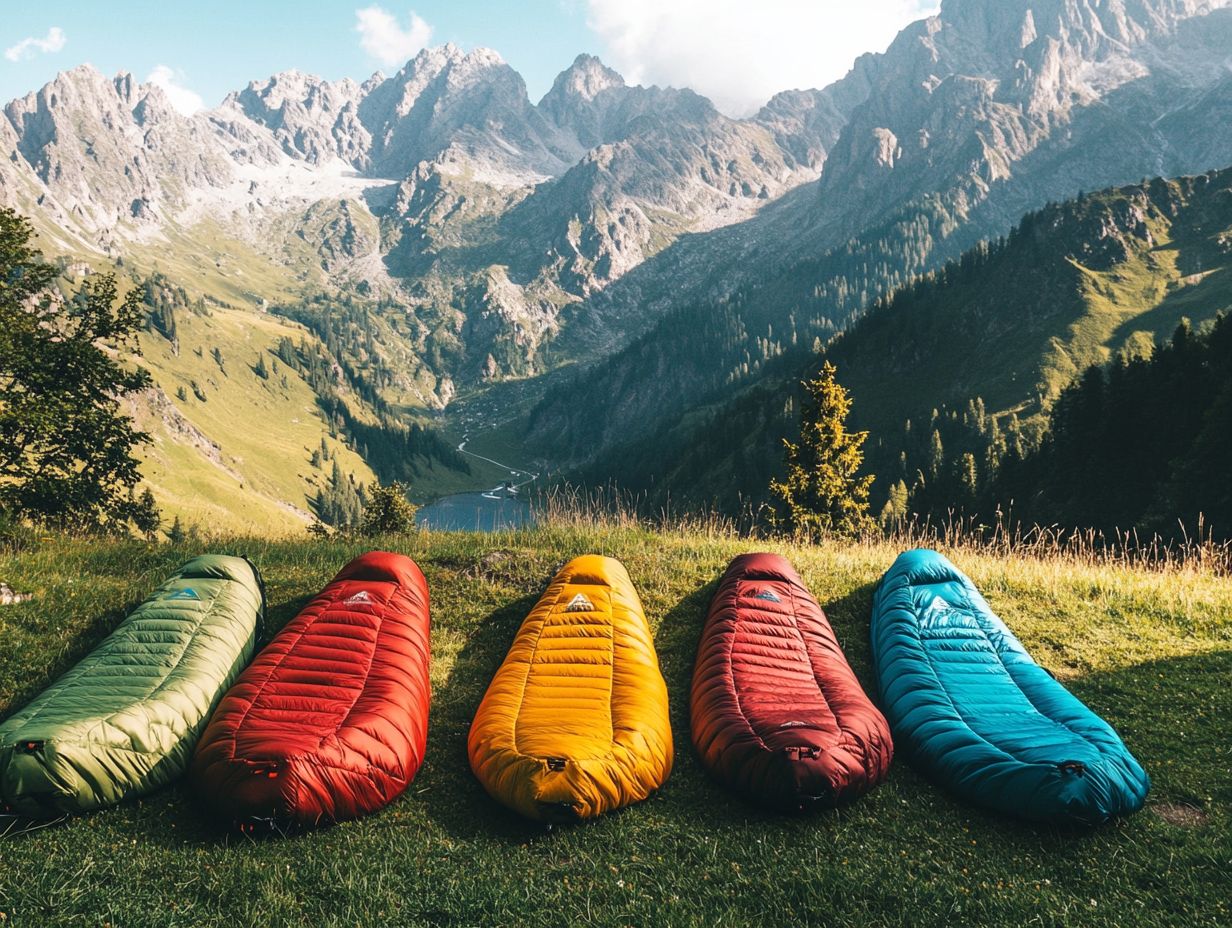
When searching for the perfect lightweight sleeping bag, consider key factors like warmth compared to weight, insulation materials, and temperature ratings. Each of these elements is crucial for a successful outdoor experience, be it in Joshua Tree National Park or the majestic Nepal Himalayas.
The right sleeping bag can significantly enhance your outdoor comfort. Temperature ratings indicate the lowest temperature at which your bag will keep you warm, helping you make informed choices for any climate.
Your choice of insulation either down or synthetic matters greatly. Down insulation, like that in Feathered Friends bags, offers excellent warmth for its weight. On the other hand, synthetic options from Therm-a-Rest excel in moisture resistance, ideal for damp conditions.
For ultralight enthusiasts, Zpacks Classic models shine with their featherlight design. They let you prioritize pack weight while ensuring warmth, making for restful nights under the stars.
How Important Is Weight and Packability?
Weight and packability are critical when choosing an ultralight sleeping bag. These factors affect how easily you can carry your gear on challenging trips, helping you keep a minimal load while maximizing comfort.
Even a slight difference in sleeping bag weight can impact your overall pack weight. For example, the ultralight Sea to Summit Spark SPI weighs just 1 pound. It compresses smaller and performs well in fastpacking scenarios where speed is key.
Consider options like the Tanager Sleeping Bag for extra warmth and comfort. It weighs closer to 3 pounds and occupies more space, which may not bother casual campers but matters for those traveling light.
What Are the Temperature Ratings?
Understanding temperature ratings is essential for choosing the right ultralight sleeping bag. These ratings indicate the lowest temperature you can expect to stay comfortable. Many models, like those from Feathered Friends, handle a 20 F limit well.
Manufacturers often use EN 13537 testing standards to determine these ratings, which evaluate a sleeping bag’s thermal performance systematically. This includes factors like insulation types and bag materials.
The comfort rating tells you the temperature at which you ll feel warm. The lower limit marks the extreme temperature before discomfort starts.
For example, Therm-a-Rest may promote a bag for 30 F nights focusing on comfort. In contrast, Zpacks might highlight a lower limit of 15 F, appealing to adventurous outdoor enthusiasts.
Understanding these distinctions helps you select gear that meets your needs across various climates.
What Type of Insulation Is Best for a Lightweight Sleeping Bag?
When you’re choosing the best insulation for your lightweight sleeping bag, you ll often find yourself weighing the pros and cons of down feathers versus synthetic insulation. Each has its unique perks, tailored to your outdoor adventures and personal preferences.
Down insulation is known for being incredibly warm while staying light. However, it has a notable drawback: it loses its heat retention when wet, which can be a serious concern in damp conditions.
Conversely, synthetic insulation, although a bit heavier and bulkier, retains its insulating properties even when wet, making it a trustworthy choice for unpredictable weather. For example, ultralight options like the Marmot Helium highlight the benefits of down with exceptional compressibility, while the REI Co-op Igneo demonstrates the effectiveness of synthetic insulation in moisture-rich environments, ensuring you stay warm and dry no matter what Mother Nature throws your way.
What Are the Different Shapes and Sizes Available?
Ultralight sleeping bags come in a variety of shapes and sizes, from traditional mummy bags to versatile lightweight quilts, catering to your diverse preferences and needs as a backpacker or camper in different environments. Each design offers unique advantages in terms of warmth and comfort.
Mummy bags, like the Therm-a-Rest Hyperion, taper towards the feet, effectively trapping heat and minimizing weight ideal for those colder climates you might encounter. If you prefer more room to move, rectangular bags are your go-to, providing space and comfort over extreme insulation.
Similarly, quilts, such as the Sea to Summit Spark, allow you to adjust ventilation and are often lighter, making them perfect for warm nights.
Understanding these differences can significantly enhance your outdoor experiences, empowering you to select the perfect option tailored to your specific needs.
What Are Some Additional Features to Consider?
When you look at ultralight sleeping bags, consider how additional features like draft collars, zipper draft tubes, and the ability to pair with an insulated jacket can significantly elevate your usability and overall sleeping experience, especially in colder climates.
These features provide extra warmth and boost your comfort during those chilly nights spent outdoors. For example, brands like Feathered Friends craft their sleeping bags with innovative draft collars that effectively trap heat, ensuring that no chilling air sneaks in. For example, Katabatic Gear employs meticulously engineered zipper draft tubes that minimize heat loss along the zipper line, which is often a vulnerable spot in traditional sleeping bags.
Such meticulous attention to detail allows outdoor enthusiasts like you to enjoy restful nights, confident that your gear is ready to meet the challenges of colder environments.
How Can a Hiker Determine the Right Sleeping Bag for Them?
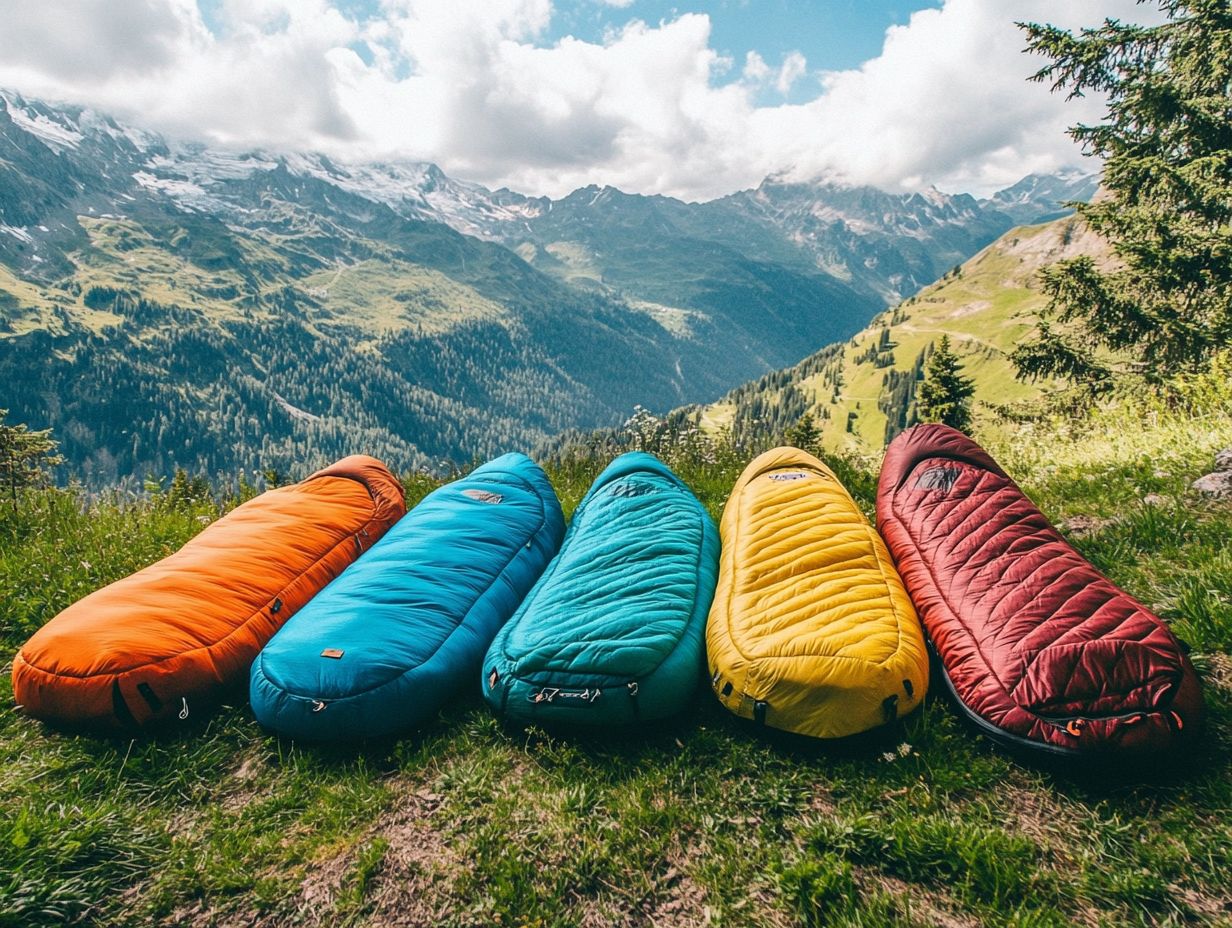
Determining the right ultralight sleeping bag depends on your personal preferences, including insulation type, temperature ratings, and intended use, ensuring that you find a sleeping solution perfectly aligned with your outdoor aspirations.
To make this choice effectively, consider your typical trekking conditions. Do you often embark on summer hikes under sunny skies, or do you find yourself braving chilly winter backpacking trips where temperatures drop significantly? In warm weather, a lightweight down bag with a higher temperature rating might be all you need, while winter adventurers like yourself may benefit from synthetic insulation for keeping you warm and dry.
Evaluating factors such as humidity, elevation, and duration of exposure can also play a significant role in your decision. By considering these factors, you ll find the perfect sleeping bag to make your outdoor adventures even more enjoyable!
What Are Some Common Mistakes to Avoid When Choosing a Lightweight Sleeping Bag?
When choosing a lightweight sleeping bag, be aware of common mistakes that stem from misjudging temperature ratings, overlooking insulation materials, or underestimating comfort ratings. These missteps can lead to unpleasant experiences on your outdoor adventures.
To navigate these pitfalls, familiarize yourself with the specific climate conditions you ll face. Selecting a sleeping bag that’s too warm could leave you sweating through the night, while one that s too cold might ruin your entire camping trip.
Ensuring a proper fit is equally important. A bag that s too snug can restrict your movement and warmth, while one that s too loose may let in cold air. Consider the type of insulation as it affects weight and performance in various weather conditions, whether down or synthetic.
How Can a Lightweight Sleeping Bag Enhance the Hiking Experience?
A lightweight sleeping bag can elevate your hiking experience by balancing comfort and warmth-to-weight ratio. This ensures restful nights, no matter the outdoor environment.
This advantage is especially valuable during long treks in diverse climates, where lugging around bulky gear can really affect your performance. Many hikers have shared how their journeys transformed after switching to ultralight sleeping options. They noted improved efficiency on the trail and better sleep quality at night.
One trekker even mentioned, “Switching to a lightweight bag removed the worry of extra weight, allowing me to focus on the hike itself!” This easy switch frees you from extra weight and contributes to a more enjoyable and less exhausting adventure, making it essential for anyone looking to maximize their outdoor experiences.
What Are Some Tips for Maintaining and Storing a Lightweight Sleeping Bag?
Proper care and storage are vital to maintaining the longevity of your lightweight sleeping bag. This ensures it remains functional and comfortable for many outdoor adventures ahead.
To start, wash the bag in a front-loading washing machine on a gentle cycle with mild detergent. Avoid bleach, as it can weaken the fibers and ruin your sleeping bag. After washing, drying it properly is crucial. Use a low-heat setting in the dryer and toss in some clean tennis balls to help maintain its loft.
Once your bag is clean and dry, store it in a breathable storage sack, which allows air circulation, instead of compression bags that can squish the insulation and diminish its effectiveness. Be mindful to avoid excessive heat or moisture, as these can degrade the materials over time.
By following these tips, you can ensure that your camping companion remains in excellent condition, always ready for your next adventure!
What Are Some Budget-Friendly Options for Lightweight Sleeping Bags?
You ll find several budget-friendly options in the ultralight sleeping bag category that offer exceptional value without skimping on essential features like warmth and packability. Take the REI Co-op Igneo, for example it s a fantastic choice that won t drain your wallet!
These sleeping bags often come in at a fraction of the cost of expensive options, yet they still deliver impressive heat retention and lightweight materials. The Teton Sports Sleeping Bag is another excellent option, providing ample insulation without breaking the bank. Then there s the Kelty Cosmic 20, which strikes a perfect balance between comfort and warmth ideal for those chillier nights!
Many of these affordable sleeping bags are designed with compressibility in mind, allowing you to easily tuck them into tight pack spaces for added convenience. This makes them perfect for budget-conscious adventurers like you, eager to explore the great outdoors without sacrificing quality and performance for a successful trip.
Frequently Asked Questions
What are the top 5 lightweight sleeping bags for hikers?
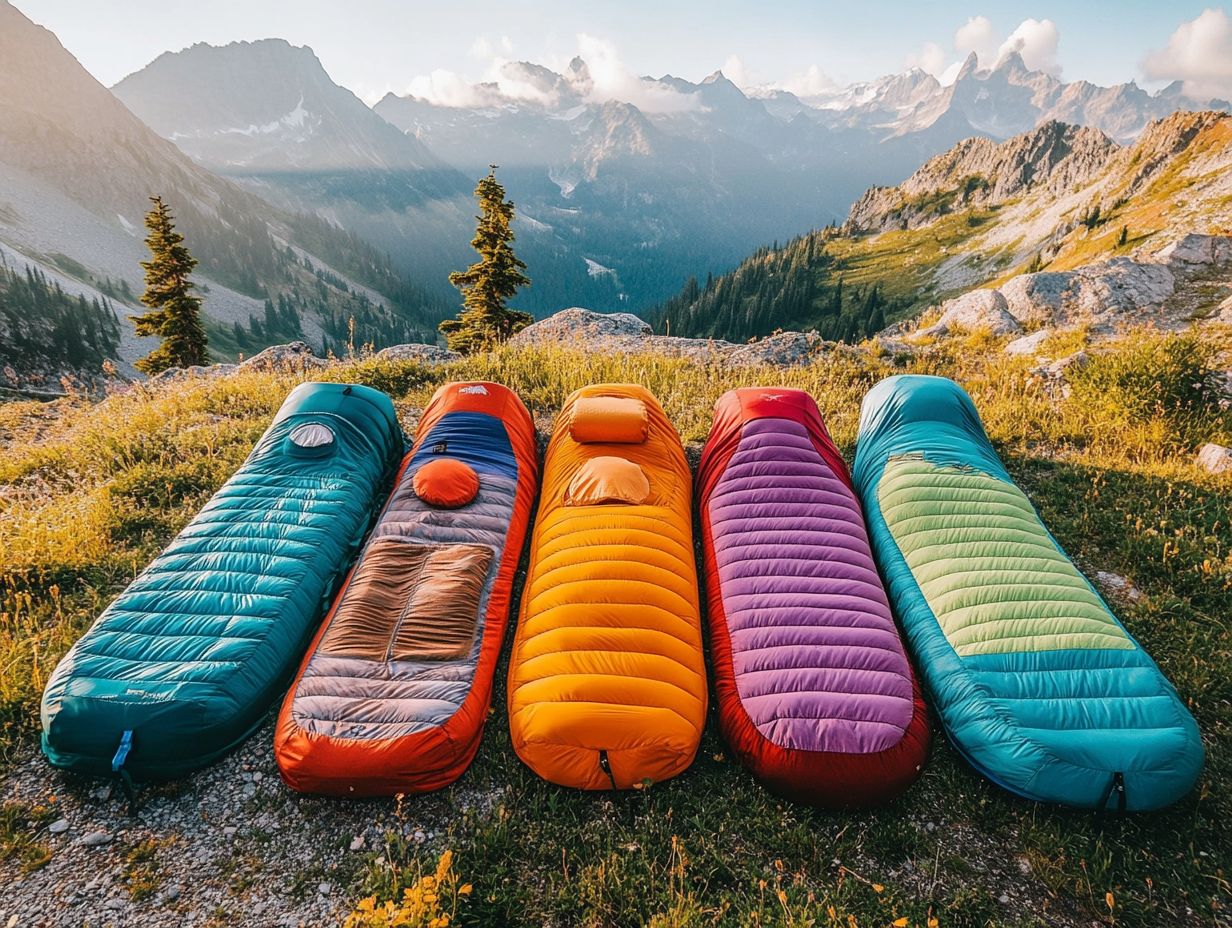
The top 5 lightweight sleeping bags for hikers are the Therm-a-Rest Hyperion 20, Marmot Hydrogen, NEMO Disco 15, Western Mountaineering Alpinlite, and Feathered Friends Egret Nano 20.
The Feathered Friends Vireo is noted for its 950 Fill Power insulation, making it a popular choice among gear enthusiasts.
What makes the Therm-a-Rest Hyperion 20 a top choice for hikers?
The Therm-a-Rest Hyperion 20 is a game-changer for hikers on the move! Its ultralight weight of only 1 pound 6 ounces keeps you warm while being lightweight.
With a warm 20 F temperature rating, it s perfect for your next unforgettable backpacking adventure!
Why is the Marmot Hydrogen a popular sleeping bag among hikers?
The Marmot Hydrogen is a popular sleeping bag among hikers because of its lightweight design. It features 900 Fill Power goose down insulation, providing warmth without adding extra weight.
This makes it a must-have for your next unforgettable backpacking trip!
What sets the NEMO Disco 15 apart from other lightweight sleeping bags for hikers?
The NEMO Disco 15 stands out with its unique spoon-shaped design. It provides more space and comfort for side sleepers, along with a versatile temperature rating that suits various conditions.
How does the Western Mountaineering Alpinlite keep hikers warm and comfortable?
The Western Mountaineering Alpinlite features a full down collar and draft tube along the zipper. This design keeps hikers warm and prevents cold drafts from seeping in, essential for maintaining comfort during cold nights in places like Zion National Park.
What makes the Feathered Friends Egret Nano 20 a top pick for hikers?
The Feathered Friends Egret Nano 20 is a top pick due to its lightweight and compressible design, making it easy to carry on long hikes. Its warm sleeping bag features and temperature ratings ensure you stay cozy in cooler weather.

